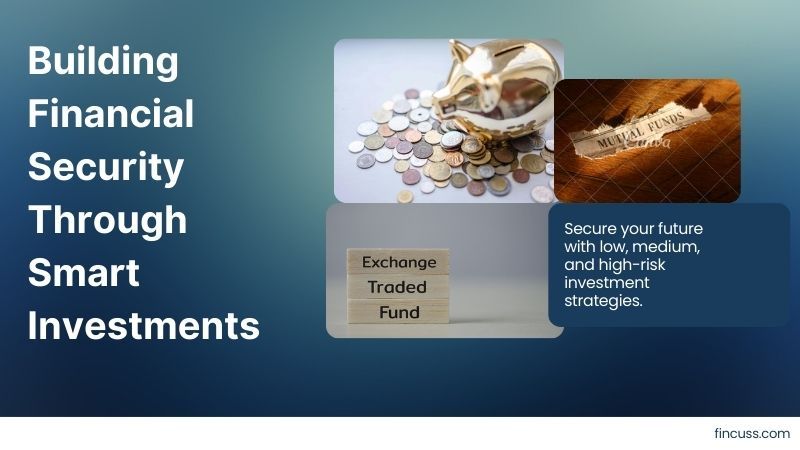Invest Wisely in 2025: Achieve your financial goals with safe, balanced investment plans.
-
Investing is crucial for financial security and achieving future goals beyond basic savings. The investment landscape in India for 2025 offers numerous opportunities. We categorize options into Low-Risk, Medium-Risk, and High-Risk categories to help you choose based on your financial goals and risk tolerance.

1. Stable Foundations: Low-Risk Investment Options
 ️
️A Low-Risk approach is typically preferred by those with a lower risk tolerance, such as retirees who have already spent years building their nest egg. These investments prioritize capital preservation and often rely on fixed-income instruments, guaranteeing returns and ensuring little to no portfolio volatility.
-
Fixed Deposits (FDs) are safe investments with stable returns, offering up to 6.95% for younger investors and 7.30% for seniors.
-
The Public Provident Fund (PPF) is a government-backed option that provides risk-free returns and tax advantages, with quarterly interest revisions.
-
Treasury Bills (T-Bills) are short-term, government-issued securities considered safe, but they yield lower returns due to their low-risk nature.
-
Sovereign Gold Bonds (SGBs) provide a fixed interest rate and capital appreciation, making them more tax-efficient than physical gold investments.
Tip: Low-risk investments are great for preserving wealth and earning stable returns, even during market volatility.
2. Seeking a Balance: Medium-Risk Investment Options
 ️
️For investors who are comfortable accepting a certain level of volatility in exchange for potentially higher returns than low-risk instruments, medium-risk investments strike an attractive balance.
Balanced Mutual Funds:
- Popular in India, these funds combine equities and debt for balanced growth and stability.
- Suitable for low-risk investors seeking higher returns through fixed-income options.
Debt Funds:
- Invest in fixed-income securities like bonds, offering lower risk compared to high-risk investments.
Exchange-Traded Funds (ETFs):
- Baskets of securities traded on stock markets, providing diversification at low costs.
- Ideal for inexperienced investors looking for diversified investments.
Dividend-Paying Stocks:
- Provide a steady income stream and are often considered "blue chip" due to their stable earnings.
Corporate Bonds:
- Debt instruments issued by businesses for short-term funding needs.
- Corporate bond funds focus primarily on these, being more cost-effective compared to bank loans.
Tip: Medium-risk portfolios often include a mix of 50–70% equity and 30–50% debt for balanced growth.
3. High Potential: High-Risk Investment Options

High-risk investments generally do not have a guaranteed return, and there is a chance they might result in losses. However, they offer the potential for exceptionally high returns if investments are made wisely. These options are typically suited for savvy investors who are keen on understanding securities and have a high-risk appetite.
Direct Equities (Stocks):
- Buying equity shares allows for decision-making involvement.
- Ideal for long-term investments but highly volatile.
Equity Mutual Funds and SIPs:
- Invest primarily in stocks, either via a lump sum or SIP.
- High market risk; ELSS offers tax benefits with a three-year lock-in.
Hedge Funds:
- Unregistered private investment partnerships with less regulation.
- High risk but potential for high returns.
Alternative Investments:
- Options like cryptocurrency and P2P lending attract young investors.
- P2P lending offers 10%-15% returns but carries a higher default risk.
- Crypto investments are volatile, with high taxes in India.
Tip: High-risk investments work best as part of a diversified portfolio to manage potential losses.
Strategizing Success: Key Investment Considerations
To navigate India's diverse investment landscape effectively, it is crucial to align your decisions with your personal circumstances and goals.
- Diversification minimizes risk and balances returns; consider varied allocations for different investment horizons.
- Aggressive growth portfolios may include 40% stocks, while safer options favor bonds and debt funds.
- Assessing your risk appetite helps determine suitable investments; risk-averse individuals should choose low-risk options.
- Long-term investments generally yield better returns due to recovery time from market volatility.
- Tax benefits can be leveraged through schemes like ULIP, PPF, ELSS, and NPS for retirement planning.
- Starting investments early maximizes compounding effects, enabling small amounts to grow significantly over time.
Conclusion
Financial stability goes beyond saving; wise investments are crucial. Assess your risk tolerance, liquidity, and goals to select suitable investment plans in India for 2025. Success relies on diversification and consistency. Start early to maximize growth and secure your future.
-
